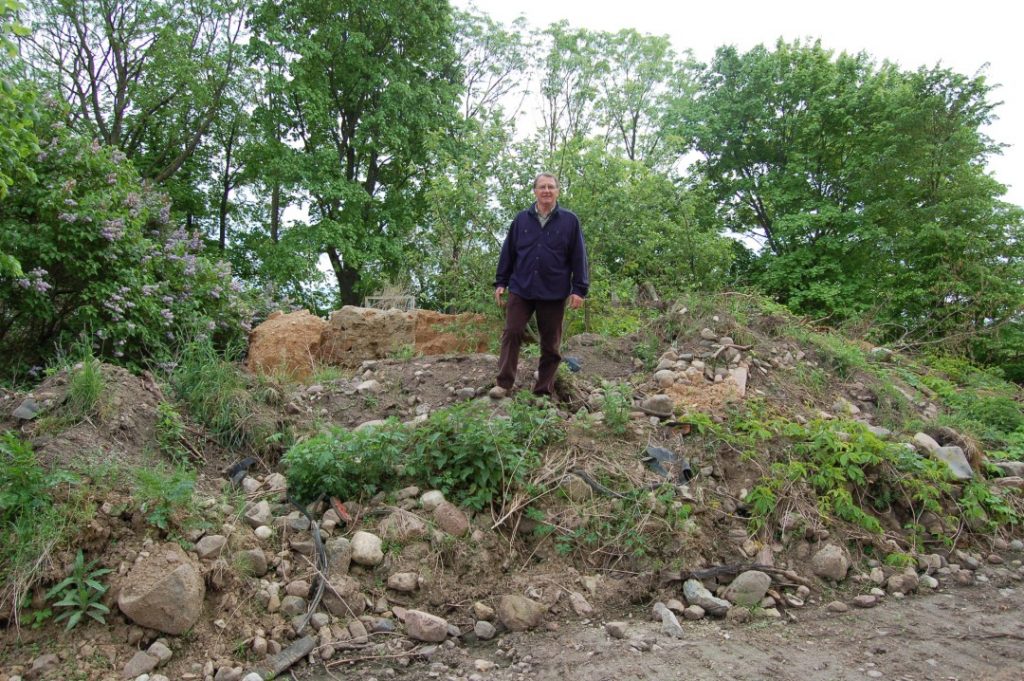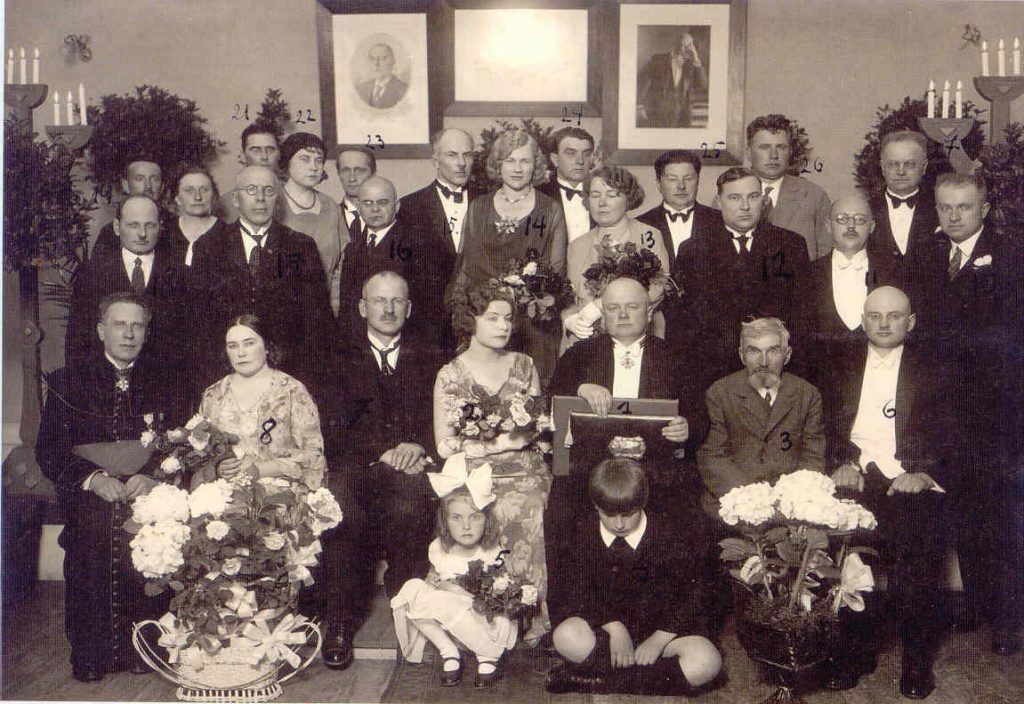Jelgavas muzejs

Pa kādas dzimtas vēstures pēdām
Ģ. Eliasa Jelgavas Vēstures un mākslas muzejs ir vieta, kur ik pa laikam iegriežas tuvāki un tālāki ciemiņi, meklējot informāciju par saviem jau mūžībā aizgājušajiem piederīgajiem, kuru dzīves gājums kaut kādā veidā ir saistīts ar Jelgavas pilsētu. Šādā nolūkā pirms pāris gadiem mūs apciemoja arī kāds centīgs un neatlaidīgs savas dzimtas vēstures pētnieks no Francijas – Seržs Kurts (Serge Kurt).
Viņa ceļš līdz Jelgavai bija nonācis tikai pēc ilgākiem meklējumiem, bet tieši Jelgava izrādījās tā pilsēta, kur arī ar mūsu – muzeja darbinieku – starpniecību, viņam izdevās iegūt vērtīgu informāciju par savas ģimenes vēsturi. Šeit viņš arī pirmoreiz savā dzīvē ieraudzīja vecātēva – Rolanda Kurta – fotogrāfiju. Vecaistēvs ir ierakstījis savu vārdu Jelgavas vēsturē ar gana lieliem burtiem. Būdams Hercoga Pētera ģimnāzijas inspektors un Jelgavas pieaugušo ģimnāzijas direktors, viņš aktīvi darbojās arī sabiedriskajā, kultūras un politiskajā laukā. Ne jau viss vēsturē un īpaši pretrunu pilnajā 20. gs. skatāms caur melnbaltu prizmu. Arī Rolanda Kurta vārds 30. un 40. gados ir saistīts ar vairākiem skandāliem un finanšu afērām mūsu pilsētā. Jāpiemin arī, ka pirmajā komunistu okupācijas gadā (1940) Rolands Kurts tika iecelts par vadošu padomju varas funkcionāru izglītības un propagandas darbā Jelgavas pilsētā. Savukārt, viņa dēls Nikolajs Kurts aktīvi darbojās komjaunatnē. Visa šī informācija bija pamatīgs pārsteigums mūsu ciemiņam Seržam, par ko viņa tēvs Nikolajs, pēc kara dzīvodams Francijā, nebija bildis ne vārda. Vēl satraucošākas mūsu ciemiņam bija ziņas, ka R. Kurts pēc kara atgriezies Jelgavā un turpinājis darbu kā bērnu nama direktors, bet atkal ticis tiesāts par saimnieciskās darbības pārkāpumiem un kopš 1946. g. nav zināmi nekādi fakti par viņa tālāko likteni. Lai nu kā Seržs vēl joprojām nav atmetis cerības, noskaidrot kaut ko vairāk par sava vecātēva gaitām Latvijā pēc Otrā pasaules kara, kā arī par sava tēva māsas Marijas likteni, kura gāja bojā mīklainos apstākļos jau pirms Otrā pasaules kara. Tāpat mūsu ciemiņš gribētu apzināt savu piederīgo kapu vietas Latvijā, lai varētu tos pienācīgi aprūpēt. Tāpēc Seržs lūdz atsaukties visus, kas varētu zināt kaut ko vairāk par viņa radinieku likteni Latvijā. Pēc mūsu ciemiņa lūguma publicējam arī viņa vēstuli angļu valodā.
Kristaps Kaktiņš, vēsturnieks, muzeja speciālists

Nikolajs Kurts Francija 1945./1946.g.
Serge Kurts, January 2014 9 Villa Rémond 94250 Gentilly (Paris) France zepli94@orange.fr + 33623531194 Dear Madam, dear Sir, Our father Nikolajs Kurts died in 1994 in Morée –Loir et Cher, France- without telling about his life in Latvia before he came to France round 1942. It has been impossible to his wife, sons and daughter to obtain more information than the following: he had been adopted in Riga by Rolands Kurts who was an important man –a professor- in contact with famous personalities such as Eisenstein, a father often taking the train (and thus not being often at home) His mother was Zinaïda Sitnik. Nikolajs had an elder sister also adopted by Rolands, she was deaf and dumb and she drowned into a river. He also had an aunt, Liouba, who married a Russian named Papkov. And that was almost everything we could obtain from him of all his life in France. In 2011, my sister Nadia adopted a Latvian boy of Ukrainian origin. I went with her in Liepaja to meet the boy and she brought him back to France were now they live heartfully. It was the first time some french Kurts went to Latvia and we had great feelings there on our father’s land. But it was a big trouble at the same time because when I asked -some time before we came- to the Latvian embassy in Paris everything we could know about Kurts in Latvia, they first answered there was no one of this name on this land. We first imagined our father was a liar and probably a sort of mythomaniac as sometimes are adopted persons who invent prestigious families and relationship.
On the road from Riga to Liepaja we, several times, met crossroads with directions indicating Jelgava, and I recalled that sometimes Nikolajs would say this word “Jelgeuveu” with some emphasis. And each time we met that direction “Jelgava” I felt there was something there for our family. But we didn’t have time enough to go further at that moment. We were here for an adoption and there was much to do else.

Biedrības Zaļā vārna saiets Jelgavā 20. gs. 20. gadu beigas. Rolands Kurts nr. 6.
When we came back to France I received a letter from Riga’s archives and it was a great emotion for all Kurts. Nikolajs was born in Moscow in 1920 He had been adopted by a Latvian citizen -Rolands Kurts- in Peterpils and taken to Jelgava in 1922, with a sister –Marija- and a Russian mother named Olga (and not Zinaïda such as Nikolajs said before). Rolands Kurts was born in 1888 at a farm named Rimzuni, Rundales pag. Bauska district. In 1924 Rolands declared to the tax office he had on charge his mother Emilija who also was living in Jelgava. He also declared Zinaïda and Wladimir Sitnik, as being step daughter and step son, students in Russia. Olga died in 1925 (it was the second mother Nikolajs was loosing, he was 5 years old). I didn’t find out when Marija died (in the Lielupe ?) It could be that this information lies in a newspaper of that time. Liouba died in 1942, during german occupation and deportation of Nikolajs by the Germans towards France. These formidable informations led me to come back in June 2012 to Riga so as to obtain the details and copies of the documents from the national archives.
Before I came I sent a letter to Rundales dome, I wanted to know if there still were some Kurts in the region or, at least, in the cemetery. The letter didn’t get at the right place but to Rundales castle where a lady received it and sent me a message soon after: “dear sir, we received your message at the castle. We apologize we have opened it and we send it right now to the dome. But I have to tell you this letter caught my eye because I’m going to marry soon a man whose parents are the present owner of your grand father’s house. Come when you wish and we’ll take you there…”

S. Kurts apciemojot savas dzimtas māju drupas Bauskas novadā
It was the beginning of a series of emotional encounters in Riga, Jelgava, Rundale.
I went to Rundale and Rimzuni with my new friends who, fortunately, and so as many Latvians, speak English as I do. I walked on my grand father’s farm ruins and visited different spots around where lived the Kurts on several generations. The family was registered on the Mežotnes parish archives since 1831. I didn’t find anything in Jelgava’s archives –where I was well received too- about other living or dead Kurts, most archives of that period having disappeared during the war and under the socialist rule.
In Riga I obtained lots of documents showing that my grand father Rolands was teacher, “inspektor” at the Petrina in the years of independence. I went to the now “Gederts Elias Jelgava” museum and was so well received by the team of historians that I obtained a picture of Rolands Kurts –I had never seen his face before- and many informations taken out of a book “Hercoga Petera gimnazija”. “Redaktors Arturs Veisbergs. Vasteras 1974”. I clearly noticed at the entrance of the Petrina this marble panel with the names of the deported students of Nov.1940 –Nikolajs was 20 years old at that time- and I made a picture of it. I wanted to check if my father and grand father had had to deal with these young people.
When I came back to France I had more questions than before, and the most important was:
why, after the war, Nikolajs never tried to know what his family had become and why he didn’t try to let know he had survived to the war and was living in France where he was building a family?
I decided to come again last July and I visited all those who had helped me in this search. Meanwhile I received other informations about my grand father who had had some trouble with justice about financial misuse in 1936. The front page of Zemgales Balss 19 junijs 1936 is: “Rolands Kurts apcietinats”. I wonder what were Nikolajs’ feelings when he went back to school the day after. Some while later I discovered that Rolands was a communist propagander -“Brivais Zemnieks” Nov. 1940 and “Jaunais Komunars” January 1941, Latvijas kareivis… I also discovered that my father Nikolajs was involved in the Komsomols. This was a surprise for me because in his life with us Nikolajs showed full resolution against the communists. I immediately wondered what position had Rolands and Nikolajs towards the deported young people of the Petrina.

Fizikas eksāmens Hercoga Pētera Ģimnāzijā 1924. g. R. Kurts sēž kreisā pusē.
Later on I discovered a picture of end 1940 that showed Nikolajs with the basket team of the HPG and some sports articles saying how many points he won with his partners: Cirulis, Gulbis, Kugrens, Silins… The picture can be seen now at the Petrina within the exposition on the occupation times.
It was time now to understand what did Rolands and Nikolajs do when the Nazis got into Latvia. It’s difficult to obtain data on that period and I will have to deal with the russian archives now. The Riga archives propose the hypothesis that Rolands fled to Russia while Nikolajs went into the direction of the Germans. Nikolajs said once that he had deserted from the Red Army because of its criminal actions. The German archives cannot explain how he arrived in France round 1942, working as a forced worker at Cherbourg on the Atlantic wall building, with another Latvian named Leonids (?) and many russian prisoners. But there he was at the end of the war.
My idea about Nikolajs silence duiring all these years, is that he was ashamed of what had happened to his class mates of the Petrina and also of his partition from his communist father.
The biggest surprise for me was when I got the information that Rolands came back to Jelgava after the war, and this, our father Nikolajs never knew. Rolands worked again in Jelgava and still acted as a communist propagander. He also created and directed a special school for workers at the commerce institute of Jelgava. Nikolajs also never has been aware that Rolands was arrested at the end of 1945 for financial misuse (again) in the management of an orphanage. It looks as if he was still taking care of his adopted son. Rolands was condemned to jail together with a man, Vilis K….. for one year and a half.
Rolands disappeared at the end of 1946 while he was asking an audience for an appeal of his sentence at the Suprem Court of Riga.
Some people still living close to Jelgava will discover with this letter what Nikolajs has become. Some may have some remembrances of Rolands and Nikolajs (such as the basketters or students). Some others would be interested to know or to say what these “disappeared people” have become. Some could say who was Nikolajs’ mother after the death of Olga, when he was 5 years old. And many would find great interest in visiting the expo at the Petrina so as to remind these tough times of occupations and war.

Māja Jelgavas centrā, kur 20. gs. 20. un 30. gados dzīvoja Kurtu ģimene
Our mother -and so do we sons and daughter- are already grateful to those who support the living memory of history, for our family and the sake of all disappeared people of these painful times. Serge Kurts



